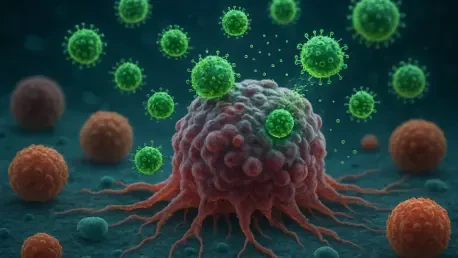Cancer remains one of the most formidable challenges in modern medicine, with treatments like chemotherapy often causing as much harm as help due to their indiscriminate attack on both cancerous and healthy cells. Imagine a scenario where a drug could be delivered with pinpoint accuracy, targeting only malignant cells while sparing the rest of the body from toxic side effects. This vision is becoming a reality through structural nanomedicine, a cutting-edge field that leverages nanotechnology to redefine how cancer therapies are designed and delivered. This review delves into the transformative potential of spherical nucleic acids (SNAs) and their role in re-engineering traditional drugs for enhanced precision and reduced harm.
Core Technology Behind Structural Nanomedicine
Structural nanomedicine focuses on the meticulous design of nanoscale structures to optimize drug delivery and therapeutic outcomes. At the heart of this innovation are spherical nucleic acids, which consist of a nanoparticle core enveloped by a dense shell of DNA or RNA. These structures are uniquely recognized by specific cell types through scavenger receptors, enabling natural uptake without the need for invasive delivery methods. This targeted approach marks a significant departure from conventional chemotherapy, which often floods the body with toxic agents, leading to severe side effects.
The brilliance of SNAs lies in their ability to integrate active drugs directly into their DNA strands. For instance, a widely used chemotherapy drug, 5-fluorouracil (5-FU), has been re-engineered into SNA frameworks to address its historically poor solubility—less than 1% dissolves in biological fluids. By embedding the drug within the DNA shell, solubility is drastically improved, allowing for more efficient delivery to cancer cells. Once inside the target cells, enzymes break down the DNA coating, releasing the active compound precisely where it is needed, thus minimizing collateral damage to healthy tissues.
Performance and Real-World Impact
Recent studies have showcased the remarkable performance of SNA-based therapies, particularly in treating aggressive cancers like acute myeloid leukemia (AML). In small animal models, the SNA-enhanced version of 5-FU demonstrated extraordinary results, entering leukemia cells 12.5 times more efficiently than the standard drug. Moreover, it proved up to 20,000 times more effective at killing cancer cells and reduced disease progression by a factor of 59. Most notably, no detectable side effects were observed, offering a stark contrast to the debilitating impacts of traditional treatments.
Beyond laboratory success, the real-world implications of this technology are profound. In animal trials, SNA therapies nearly eradicated leukemia cells in blood and spleen samples, significantly extending survival rates. This precision targeting, driven by the interaction of SNAs with overabundant myeloid cells in AML, suggests a future where patients could undergo treatment without the fear of nausea, fatigue, or more severe complications like heart failure. The potential to deliver higher, focused doses directly to cancer sites could redefine the standard of care in oncology.
The versatility of structural nanomedicine extends beyond cancer, with applications being explored in vaccines, infectious diseases, neurodegenerative disorders, and autoimmune conditions. Currently, several SNA-based therapies are in clinical trials, indicating growing confidence in their scalability. If these trials, expected to progress over the next few years from 2025 onward, yield positive results, this technology could become a cornerstone of personalized medicine across multiple fields.
Challenges in Scaling and Adoption
Despite the promising results, significant hurdles remain in bringing structural nanomedicine to widespread clinical use. One major challenge is the production of SNAs at scale, as ensuring consistent quality and drug release across diverse biological environments is technically complex. Variations in patient physiology and disease progression could affect how these nanostructures perform, necessitating rigorous testing to standardize outcomes.
Additionally, while small animal studies have shown impressive efficacy, translation to larger animal models and human trials is critical. These next steps require substantial funding and regulatory approval, both of which pose potential bottlenecks. The complexity of navigating medical regulations, coupled with the high costs of advanced nanotechnology research, could delay the adoption of SNA-based therapies in mainstream healthcare settings.
Final Thoughts on Structural Nanomedicine
Looking back on the advancements in structural nanomedicine, it is clear that this technology offers a groundbreaking shift in how cancer treatment is approached. The precision of spherical nucleic acids in targeting malignant cells while sparing healthy tissues stands out as a remarkable achievement in early studies and trials. As the field moves forward, the focus shifts to actionable steps like accelerating clinical trials and securing partnerships to fund larger-scale testing. Overcoming production challenges and regulatory barriers emerges as the next critical frontier, with the hope that collaborative efforts between researchers and policymakers will pave the way for broader access. Ultimately, the journey of structural nanomedicine underscores a compelling vision of medicine—tailored, effective, and compassionate—that demands continued investment and innovation to fully materialize.









